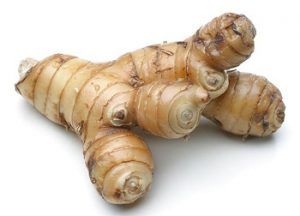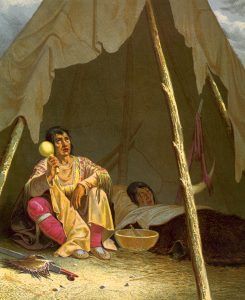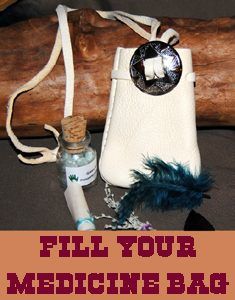Herbs A B C D E F G H I J K L M N O P Q R S T U V W X Y Z
G
Galangal – Belonging to the ginger family of plants, it is also called Blue Ginger, Gao Liang, and Laos and has both culinary and medicinal uses. Originating in Indonesia, it was brought to Europe around the 9th century. Its use in herbal medicine has long been known for its warming and comforting effects on digestion, similar to other ginger-related herbs. Its mild spicy taste makes it a very soothing herb used throughout the years to treat abdominal pain, vomiting, hiccups, diarrhea, flatulence, canker sores, sore gums, and motion sickness.
Garcinia Cambogia – Scientifically known as Garcinia Gummi-Gutta, this subtropical plant is native to Indonesia and is also called Gambooge, Brindall Berry, Malabar Tamarind, Garcinia, Citrin, Gardinia Kola, Mangosteen Oil Tree, and others. This flowering evergreen tree produces a yellow oval-shaped fruit that resembles small pumpkins, of which the rind has long been used in herbal medicines. Through the years, it has been used to treat swelling, delayed menstruation, constipation, worms, rheumatism, bowel complaints, energy, endurance, gastric ulcers, diarrhea, dysentery, and as an appetite suppressant. Not recommended for those with diabetes, people suffering any dementia syndrome or pregnant and lactating women.
Gentiana – A genus of flowering plants belonging to the Gentianaceae family, which has more than 400 species. Common names include Bitter Root, Bitter Wort, Gal Weed, Yellow Gentian, Sampsons Snakeroot, Longdan, and Qin Jiao. Growing in alpine habitats all over the world, most species have pretty, deep blue flowers. Though it has an extremely bitter taste, it was commonly used by Native Americans to treat digestive ailments and as an appetite stimulator. Various species were also used to treat Malaria, stimulate menstruation, and rid the body of worms. It was also used topically to treat wounds and painful inflammation, one species of which, the Catawba Indians, used the roots in hot water on aching backs. Gentian consumption may cause irritation in persons who have ulcers and may also cause headaches, nausea, or vomiting.
Geranium – Of the Pelargonium species, there are about 200 types of Geraniums found throughout the world. Other common names include Scented Geranium and Stork’s Bill. In traditional folk medicine, scented geranium leaves were used in teas to treat ulcers, headaches. In Native American medicine, the Cherokee were known to have boiled geranium root together with wild grape, which was used to rinse the mouths of children affected with thrush. The Chippewa and Ottawa tribes boiled the entire geranium plant and drank the tea for diarrhea.
Ginger Root – The root of the Zingiber Officinale plant, it is consumed throughout the world as both a medicine and a spice. Ginger cultivation began in South Asia and has since spread to East Africa and the Caribbean. It has long been used for digestive problems and nausea, specifically motion sickness, heartburn, bloating, flatulence, and gastrointestinal problems. It is also a known remedy for colic, irritable bowel, loss of appetite, chills, cold, flu, poor circulation, menstrual cramps, stomach cramps, fever, headache, toothache, cough, and bronchitis. A powerful anti-inflammatory herb, it has also been used for arthritis, joint problems, rheumatism, and tendonitis. It also is reportedly effective in lowering cholesterol and blood pressure and prevention of internal blood clots.
Ginkgo Biloba – Believed to be one of the most ancient species of trees still in existence, Ginkgo Biloba trees are grown in Korea, China, southern France, and in the eastern and southern United States. The trees can live as long as 1,000 years, and their leaves have long been used for food and medical treatments. It is most commonly used to treat the elderly for disorientation, depression, memory loss, headache, dementia, Alzheimer’s Disease, tinnitus, and vertigo because of its positive effects as a circulatory aid. It has also been found to be effective for circulation problems, ADHD, cramps, high blood pressure, and as an antioxidant.
Ginseng – Numerous species belonging to the Panax genus can be found throughout the world, and their roots and leaves have long been used throughout history in herbal medicines. Several species grow around the world, including Panax Ginseng, Siberian Ginseng, and American Ginseng. Though some are preferred for specific benefits, all are considered to have similar properties. The name Panax is derived from the Greek word panacea meaning, “all healing.” The most commonly used is Panax Ginseng, also called Asian or Korean Ginseng. Native to China, Korea, and Russia, it has been an important herbal remedy in traditional Chinese medicine for thousands of years, primarily as a treatment for weakness and fatigue. Over the years, it has also been used in a variety of other ailments, including diabetes, sexual dysfunction in men, reduces stress, boosts energy, enhances memory, and stimulates the immune system. Research has shown specific effects that support the central nervous system, liver function, lung function, and circulatory system. The root is most often available in dried form, either whole or sliced; however, Ginseng leaves and stems, although not as highly prized, are also used in dried form.
Glucomannan – A sugar made from the root of the Konjac Plant, it is a dietary fiber that has been long used in Asia in traditional foods such as noodles and tofu. Its known uses in medicinal medicine include the treatment of constipation and Type 2 diabetes, as well as lowering cholesterol and weight loss. It is not recommended for use by pregnant or breastfeeding women.
Goldenrod – Officially called Solidago Canadensis or Solidago Virgaurea, Goldenrod has long been used topically for wound healing. It has also been used to treat tuberculosis, diabetes, enlargement of the liver, gout, hemorrhoids, internal bleeding, asthma, arthritis, colds, flu, kidney stones, bladder, and urinary inflammation, allergies, laryngitis, and sore throat, mouth ulcers, cuts, and abrasions. It has the ability to fight off infection because it has both antimicrobial and anti-inflammatory elements.
Goldenseal – Officially known as Hydrastis Canadensis, this herb of the Buttercup family is also known as Yellow Root, Orange Root, Puccoon, Ground Raspberry, and Wild Curcuma. Native to southeastern Canada and the northeastern United States, it was traditionally used by Native Americans to treat skin disorders, digestive problems, liver conditions, diarrhea, as a stimulant, and for eye irritations. The Cherokee were also known to have pounded the large rootstock with bear fat and smeared it on their bodies as insect repellent. The herb was introduced to early colonists for medical use by the Iroquois. It has also been used for infections of the mucus membranes, including the mouth, sinuses, throat, intestines, stomach, urinary tract, and vagina, as well as for minor wound healing, colds, flu, bladder infections, and sinus and chest congestion. Goldenseal should not be taken by pregnant women.
Green Hellebore – See Hellebore
Green Tea – Made solely with the leaves of Camellia Sinensis, Green Tea originates from China and has long been associated with Asian cultures, though it has become more widespread in the West. It has been consumed throughout the ages in India, China, Japan, and Thailand, where it has long been used as a stimulant, a diuretic, to control bleeding, heal wounds, improve heart health, treat flatulence, promote digestion, regulate blood sugar, and improve mental processes. More recently, it has been used to lower cholesterol, promote weight loss, and treat cancer, diabetes, inflammatory bowel disease, and liver disease. It may also be useful in inflammatory diseases, such as arthritis, as well as treating colds and flu.
Grapefruit – A subtropical citrus tree grown throughout the world, it is known for its bitter fruit. Not only is it known as an excellent source of many nutrients that contribute to a healthy diet, but its seeds, pulp, and inner rind have also been found to be helpful in fighting both bacterial and fungal infections. A good source of vitamin C, grapefruit also contains beneficial antioxidants, and evidence shows it can help lower cholesterol, can prevent kidney stones, and protect against colon cancer. The vitamins and nutrients found in grapefruit peel have been used to settle stomach aches. Grapefruit seed extracts have been utilized as a preventative when people travel to places where the water is questionable. It also has a cleansing effect on the kidneys, is said to help reduce obesity, and has been used to treat muscle fatigue, stiffness, acne, fluid retention, increase circulation, and as an antiseptic and astringent.
Greenbriar – Officially known as Smilax Bona-Nox, it is a member of the larger Smilax family of more than 300 species. Also known by several other names such as Bullbriar, Catbriar, Horsebriar, Prickly-ivys, and Pull Out a Sticker to the Cherokee, it grows in temperate zones, tropics, and subtropics worldwide. The flowering plants, many of which are woody and/or thorny, its root has often been used as a diuretic, the treatment of dropsy, urinary complaints, and as a blood purifier. Tea made from the roots has been used to help the expelling of afterbirth and as a general tonic for the treatment of rheumatism and stomach problems. Stem prickles were often rubbed on the skin as a counter-irritant to relieve localized pains, muscle cramps, and twitching, and poultices and salves were made from the leaves and bark for application on minor sores, boils, burns, and arthritis. Sarsaparilla is also a member of the larger Smilax family.
Guarana – A climbing plant native to the Amazon Basin, it contains caffeine and is generally used as a mild stimulant. Other uses over the years include treating headache, mild depression, chronic diarrhea, fatigue, arthritis, urinary tract irritation. Similar to coffee, it stimulates the nervous system, boosts energy, increases metabolism, and reduces hunger. Traditionally, it was also used to prevent malaria and dysentery and as an aphrodisiac.
Gymnema Sylvestre – An herb native to the tropical forests of India, it has been used there as a natural treatment for diabetes for nearly 2,000 years. Also called Cowplant, the whole plant is used in decoctions to control blood sugar, reduce cholesterol, and treat snake bites, malaria, digestive problems, constipation, cough, fever, and urinary conditions.
H
Hawthorn – Of the Crataegus species, Hawthorn has been used to treat heart disease as far back as the 1st century. By the early 1800s, American doctors were using it to treat circulatory disorders and respiratory illnesses. Traditionally, the berries were used to treat heart problems ranging from irregular heartbeat, high blood pressure, chest pain, hardening of the arteries, and heart failure. Today, the leaves and flowers are used medicinally, and there is good evidence that hawthorn can treat mild-to-moderate heart failure. Animal and laboratory studies report hawthorn contains antioxidants.
Hellebores – Commonly known as Hellebore, these flowering plants were native to Eurasia; there are approximately 20 species, many of which are poisonous. Also known as Bugbane, Devil’s Bite, Earth Gall, Indian Poke, Itchweed, and Tickleweed, it has long been used in old medicinal remedies but is no longer used today as the herb has been found to be severely toxic and has numerous severe side effects, even in therapeutic dosages. Historically, American Hellebore was used internally to treat pneumonia, peritonitis, epilepsy, pain, asthma, colds, cholera, croup, consumption, dyspepsia, fever, hypertension, herpes, gout, headache, inflammation, whooping cough, sciatica, rheumatism, shingles, toothache, scrofulous, tumors, and typhus. It was used as a gargle for throat infections and tonsillitis and externally for skin irritations. The Cherokee were known to have used the green hellebore to relieve body pains.
Hibiscus – A genus of flowering plants in the Mallow family, this showy plant, which grows all over the world, has long been used in traditional herbal medicines dating back to Roman times. There are more than 250 species of herbs, shrubs, and trees of the Mallow or Malvaceae family; but, the most commonly used for medicinal purposes are Hibiscus Sabdariffa, commonly known as the Roselle; Hibiscus Rosa-Sinensis, also called China Rose and Common Hibiscus; and Hibiscus Syriacus, known as the Rose of Sharon. Utilizing all parts of the plant, Roselle has been used for fever, high blood pressure, and cough; Common Hibiscus used mainly for respiratory problems but is also for skin disorders. Used externally as an emollient and internally for gastrointestinal disorders. Other uses over the years have included treatment for constipation, skin conditions, hemorrhoids, menstrual cramps, wounds, tuberculosis, PMS, stomach problems, headache, as well as easing labor pains and lowering blood pressure.
Honeysuckle – Formally called Lonicera, there are hundreds of species of honeysuckle, which have been used in traditional herbal remedies for thousands of years. The fruit, juice of the plant, stems, flowers, and leaves have been used to treat bee stings, asthma, rheumatoid arthritis, mumps, hepatitis, or upper respiratory tract infections, such as pneumonia, skin infections, tumors, dysentery, colds, sores, viruses, headache, sore throat, fever, and blood pressure. It has also been found to have antibacterial, anti-toxin, anti-inflammatory, anti-spasmodic, and purifying properties.
Hops – Native throughout Europe and Asia, the female flower clusters, commonly called seed cones or strobiles, has long been known as the flavoring and stability agent in beer. However, they were also used in traditional herbal medicine for a variety of conditions. Because of its bitter ingredients, it has long been used as a digestive aid, as well as relieving tension, and as a sleep aid. Sometimes used alone, but, most often utilized with other herbs, they were also used to treat anxiety, restlessness, to soothe muscles. In popular folk medicine, a sachet filled with hops was often used inside a pillow, where the aromatic properties of the herb would help a person fall asleep. In Native American remedies, the Mohegan tribe were known to have prepared a sedative medicine that was applied to a toothache; the Dakota people used tea to relieve pains of the digestive organs, and the Menominee tribe regarded a related species of hops as a general panacea.
Horehound – Technically called Marrubium Vulgare, this plant of the Mint family is a native to Europe but is now naturalized throughout North and South America. Having several common names, including Bull’s blood, Eye of the Star, Houndsbane, Devil’s Eye, Hog Bean, Poison Tobacco, and others, it has long been used to treat digestive disorders, as well as a number of other ailments. Horehound has medicinally substantiated value as a cough suppressant and expectorant and is still used in making cough drops and cough syrups. Other uses include treatment of constipation, gastric problems, indigestion, flatulence, painful menstruation, bronchitis, asthma cough, colds, nausea, tuberculosis, whooping cough, and as a sedative and appetite stimulant. Externally, it has been used as a cleansing agent for wounds and to treat skin disorders, sores, abrasions. People with gastritis or peptic ulcer disorders should use it cautiously. Children have been poisoned by eating the seeds.
Horse Gentian – See Feverwort
Horsemint – Officially known as Mentha Longifolia, this is a species of the Mint family native to Europe and Asia; it has long been valued for its antiseptic properties and effect on digestion. Leaves and flowering stems have also been used in teas and tonics to treat fever, headache, inflammation, chills, colic, menstrual disorders, flatulence, congestion, cough, colds, and urinary tract infections. It has also been used as a stimulant and to induce labor. Externally, it was used on swelling, sores, and minor wounds. Leaves and stems were often added to boiling water, and the vapors were inhaled to relieve nasal and bronchial congestion. In Native American Medicine, the Catawba tribe crushed and steeped fresh horsemint leaves in cold water and drank the infusion to allay back pain. Other tribes used horsemint for fever, inflammation, and chills. It should not be used by pregnant women.
Disclaimer: These statements have not been evaluated by the Food and Drug Administration, and we make no medical claims nor intend to diagnose, treat, or heal medical conditions. Women who are pregnant or nursing or persons with known medical conditions should consult their physician before taking any herbal products.
Also See:



